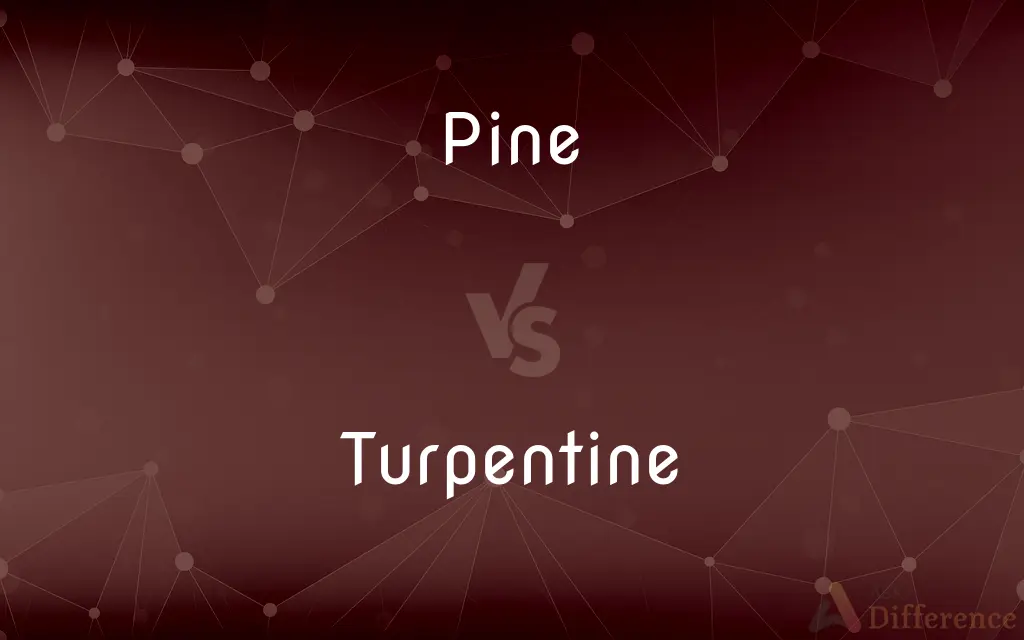Pine vs. Turpentine — What's the Difference?
Edited by Tayyaba Rehman — By Maham Liaqat — Updated on April 8, 2024
Pine refers to evergreen trees with needle-like leaves, known for their wood and resin, while turpentine is a volatile fluid obtained from the distillation of pine resin, used as a solvent and in making varnishes.

Difference Between Pine and Turpentine
Table of Contents
ADVERTISEMENT
Key Differences
Pine trees are a type of evergreen, contributing significantly to forest ecosystems and timber industries, with their needle-like leaves and coniferous characteristics. They are valued for their wood, used in construction and furniture making. On the other hand, turpentine is a product derived from the resin of pine trees, specifically obtained through the distillation process. It is known for its strong smell and its use as a solvent in paint and varnish.
The relationship between pine trees and turpentine is a direct one, where the latter is a byproduct of the former. While pine trees serve a primary role in natural and cultivated landscapes, providing habitat and material, turpentine serves as an essential component in various industrial applications, including the art and cleaning industries. Turpentine's roles, while derived from pine, diverge significantly in terms of its usage and handling.
Pine trees have various species, each with its own unique characteristics and adaptations, contributing to biodiversity and serving different roles in ecosystems and economies. Turpentine, although sourced from these trees, is a more uniform product with specific chemical properties, including terpenes, that make it valuable as a solvent and in the production of synthetic pine oil and other chemical compounds.
Environmental impacts of both pine cultivation and turpentine production are notable. Sustainable management of pine forests is crucial for ecological balance, carbon sequestration, and maintaining biodiversity. In contrast, the extraction and distillation process for producing turpentine must be managed to minimize environmental damage, considering the potential for chemical emissions and the impact on local ecosystems.
While pine trees are celebrated for their natural beauty, ecological benefits, and the renewable resource of timber, turpentine is appreciated for its practical applications in industries. Both have significant roles but differ greatly in terms of their nature, usage, and impact on the environment and society.
ADVERTISEMENT
Comparison Chart
Definition
Evergreen trees known for needle-like leaves.
Volatile fluid obtained from pine resin.
Primary Use
Timber, paper production, and decoration.
Solvent in paint, varnish, and medicinal uses.
Source/Origin
Grows naturally in forests; cultivated in plantations.
Distilled from the resin of pine trees.
Environmental Impact
Provides habitat, affects biodiversity, used in reforestation.
Chemical emissions during production, used in industrial applications.
Chemical Composition
Wood and resin rich in cellulose and lignin.
Contains terpenes like alpha-pinene and beta-pinene.
Compare with Definitions
Pine
Trees that are widely used in the timber industry for their softwood.
Pine wood is preferred for furniture due to its durability and workability.
Turpentine
A volatile oil distilled from pine resin, used as a solvent and in making varnishes.
Artists use turpentine to thin oil paints and clean brushes.
Pine
Characterized by their distinctive coniferous form and aromatic wood.
The scent of pine wood is often associated with cleanliness and freshness.
Turpentine
Known for its strong, pungent odor and its role in traditional remedies.
Turpentine has been historically used as a home remedy for various ailments.
Pine
Pines produce cones and have adaptations for surviving in various climates.
Pine trees have adapted to withstand cold by having needle-like leaves.
Turpentine
A key industrial ingredient in the production of synthetic pine oil and camphor.
Turpentine is processed to synthesize chemicals used in fragrances and flavorings.
Pine
A genus of evergreen trees with needle-like leaves, known for their wood and resin.
The pine trees towered over the landscape, providing shade and habitat.
Turpentine
Environmental considerations are taken into account in its production and disposal.
Proper handling of turpentine is important due to its flammable and toxic nature.
Pine
Sources of resin, which has multiple uses including in turpentine production.
The resin from pine trees is harvested for producing turpentine and rosin.
Turpentine
Acts as a solvent, dissolving certain types of paints and varnishes.
Turpentine is effective in removing oil-based paint stains from clothing.
Pine
A pine is any conifer in the genus Pinus () of the family Pinaceae. Pinus is the sole genus in the subfamily Pinoideae.
Turpentine
Turpentine (which is also called gum turpentine, spirit of turpentine, oil of turpentine, wood turpentine, terebenthene, terebinthine and (colloquially), turps) is a fluid obtained by the distillation of resin harvested from living trees, mainly pines. Mainly used as a specialized solvent, it is also a source of material for organic syntheses.
Pine
An evergreen coniferous tree which has clusters of long needle-shaped leaves. Many kinds are grown for the soft timber, which is widely used for furniture and pulp, or for tar and turpentine.
Turpentine
A volatile pungent oil distilled from gum turpentine or pine wood, used in mixing paints and varnishes and in liniment.
Pine
A pineapple.
Turpentine
Any of a number of trees which yield turpentine or a similar resin.
Pine
Suffer a mental and physical decline, especially because of a broken heart
She thinks I am pining away from love
Turpentine
Apply turpentine to
Antique turpentining equipment
Pine
Any of various evergreen trees of the genus Pinus, having fascicles of needle-shaped leaves and producing woody seed-bearing cones. These trees are widely cultivated for ornament and shade and for their timber and resinous sap, which yields turpentine and pine tar.
Turpentine
A thin volatile terpenoid essential oil, C10H16, obtained by steam distillation or other means from the wood or exudate of certain pine trees and used as a paint thinner, solvent, and medicinally as a liniment. Also called oil of turpentine, spirit of turpentine.
Pine
Any of various other coniferous trees, such as the Norfolk Island pine.
Turpentine
The sticky mixture of resin and volatile oil from which turpentine is distilled.
Pine
The wood of any of these trees.
Turpentine
A brownish-yellow resinous liquid obtained from the terebinth.
Pine
Intense longing or grief.
Turpentine
To apply turpentine to or mix turpentine with.
Pine
To feel a lingering, often nostalgic desire.
Turpentine
To extract turpentine from (a tree).
Pine
To wither or waste away from longing or grief
Pined away and died.
Turpentine
Any oleoresin secreted by the wood or bark of certain trees.
Pine
To grieve or mourn for.
Turpentine
A volatile essential oil now obtained from such oleoresin of from the wood of pine trees by steam distillation; a complex mixture of monoterpenes; now used as a solvent and paint thinner.
Pine
Any coniferous tree of the genus Pinus.
The northern slopes were covered mainly in pine.
Turpentine
(transitive) To drain resin from (a tree) for use in making turpentine.
Pine
(countable) Any tree (usually coniferous) which resembles a member of this genus in some respect.
Turpentine
A semifluid or fluid oleoresin, primarily the exudation of the terebinth, or turpentine, tree (Pistacia Terebinthus), a native of the Mediterranean region. It is also obtained from many coniferous trees, especially species of pine, larch, and fir.
Pine
(uncountable) The wood of this tree.
Turpentine
Obtained from conifers (especially pines)
Pine
A pineapple.
Turpentine
Volatile liquid distilled from turpentine oleoresin; used as paint thinner and solvent and medicinally
Pine
(archaic) A painful longing.
Pine
(intransitive) To languish; to lose flesh or wear away through distress.
Pine
(intransitive) To long, to yearn so much that it causes suffering.
Laura was pining for Bill all the time he was gone.
Pine
(transitive) To grieve or mourn for.
Pine
(transitive) To inflict pain upon; to torment.
Pine
Woe; torment; pain.
Pine
Any tree of the coniferous genus Pinus. See Pinus.
Pine
The wood of the pine tree.
Pine
A pineapple.
Pine
To inflict pain upon; to torment; to torture; to afflict.
That people that pyned him to death.
One is pined in prison, another tortured on the rack.
Pine
To grieve or mourn for.
Pine
To suffer; to be afflicted.
Pine
To languish; to lose flesh or wear away, under any distress or anexiety of mind; to droop; - often used with away.
Pine
To languish with desire; to waste away with longing for something; - usually followed by for.
For whom, and not for Tybalt, Juliet pined.
Pine
A coniferous tree
Pine
Straight-grained durable and often resinous white to yellowish timber of any of numerous trees of the genus Pinus
Pine
Have a desire for something or someone who is not present;
She ached for a cigarette
I am pining for my lover
Common Curiosities
What is pine used for?
Pine is primarily used for its timber in construction, furniture making, and as a source of resin.
How is turpentine made?
Turpentine is made by distilling the resin collected from pine trees.
How do pine trees benefit the environment?
Pine trees contribute to carbon sequestration, provide habitats for wildlife, and can be used in reforestation and erosion control efforts.
Can all pine trees produce turpentine?
While most pine trees produce resin from which turpentine can be distilled, certain species are preferred for commercial turpentine production due to their resin content and composition.
What are the safety concerns with turpentine?
Turpentine is flammable and can be toxic if ingested or inhaled in large quantities, necessitating proper handling and storage.
Are pine wood and turpentine sustainable?
Sustainability depends on responsible forestry and production practices, including reforestation and minimizing waste and emissions in turpentine production.
What makes turpentine a good solvent?
Its chemical composition allows it to dissolve certain substances, making it useful in paint thinning and removal.
Is turpentine environmentally friendly?
While turpentine is a natural product, its production and use have environmental impacts, requiring careful management and disposal to minimize harm.
How does the production of turpentine affect pine forests?
Sustainable practices can minimize impact, but overharvesting of resin can damage trees and reduce forest health if not managed properly.
Why are pine trees important for ecosystems?
They play a crucial role in their ecosystems, offering habitats, influencing soil composition, and participating in the water cycle.
What distinguishes pine resin from turpentine?
Pine resin is a thick, sticky substance extracted from pine trees, while turpentine is the volatile oil distilled from this resin.
Can turpentine be used in medicine?
Historically, turpentine was used in traditional medicine, though its use today is limited and should be approached with caution due to its potential toxicity.
What are the alternatives to using turpentine?
Water-based solvents and mineral spirits can be used as less toxic alternatives for some applications.
How can one safely dispose of turpentine?
Due to its hazardous nature, it should be disposed of according to local hazardous waste management guidelines.
How is pine wood processed for use?
Pine wood is typically sawn, dried, and treated to improve durability and resistance to decay, making it suitable for various uses.
Share Your Discovery

Previous Comparison
Paradigm vs. Syntagm
Next Comparison
Swan vs. CraneAuthor Spotlight
Written by
Maham LiaqatEdited by
Tayyaba RehmanTayyaba Rehman is a distinguished writer, currently serving as a primary contributor to askdifference.com. As a researcher in semantics and etymology, Tayyaba's passion for the complexity of languages and their distinctions has found a perfect home on the platform. Tayyaba delves into the intricacies of language, distinguishing between commonly confused words and phrases, thereby providing clarity for readers worldwide.














































